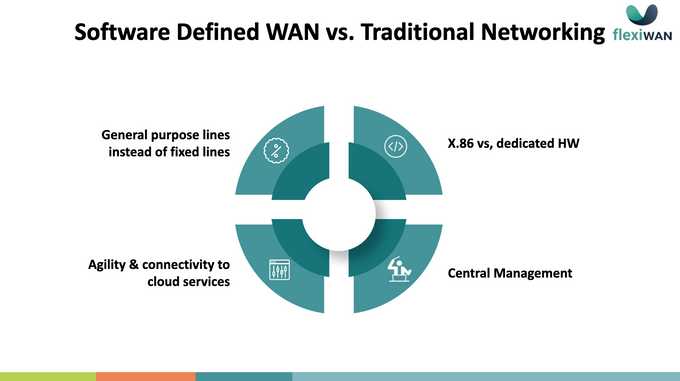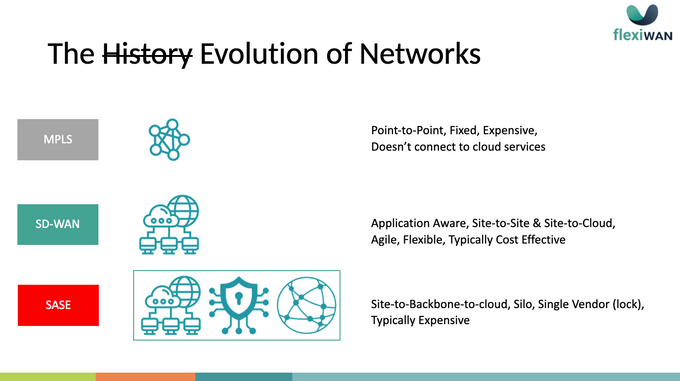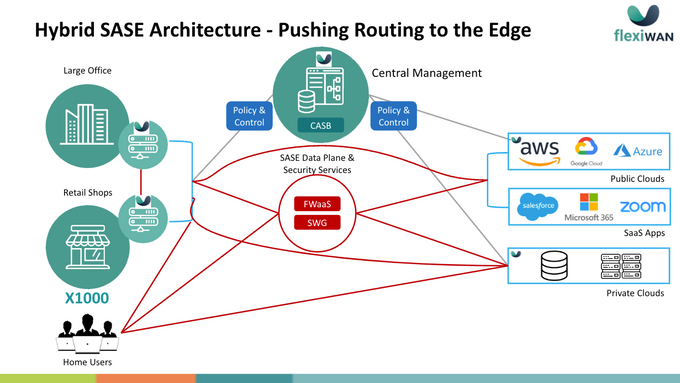SD-WAN vs. SASE: The Crossroads of Modern Networking
SD-WAN and SASE are two enterprise networking and security solutions with different advantages and disadvantages. Compare the benefits and challenges here to help decide which is right for you.
Updated May 28, 2024

As businesses explore the future of enterprise networking, the decision between implementing Software-Defined Wide Area Networking (SD-WAN) and Secure Access Service Edge (SASE) emerges as a critical choice.
Understanding SD-WAN
The evolution of enterprise networking has seen a significant shift from traditional networking solutions, such as MPLS (multiprotocol label switching) and VPNs (virtual private networks), to more agile and cost-effective approaches like SD-WAN. This transition marks a pivotal change in how businesses connect their various locations and access cloud services, offering a blend of flexibility, efficiency, and performance previously unattainable with conventional methods.
The Problem With MPLS and VPNs
Traditional networking approaches, like MPLS and VPNs, offer point-to-point connectivity, which is essential for business operations.
These methods were characterized by their rigidity, high costs, and limited adaptability, especially in the face of the rapidly evolving digital transformation where applications are consumed from the cloud.
The need for direct, static connections between offices or between an office and the cloud has posed challenges to scalability and agility, hindering businesses' ability to adapt to new technologies and work practices.
SD-WAN Architecture and Design
SD-WAN, short for Software-Defined Wide Area Networking, emerged as a solution to the limitations of traditional networking, offering a centrally managed, application-aware infrastructure that supports dynamic site-to-site and site-to-cloud connectivity.
SD-WAN, with its revolutionary approach to managing wide area networks, offers flexibility, cost efficiency, and enhanced network performance, tailored specifically for the needs of modern enterprises. It marks a significant shift from traditional network architectures, focusing on software-driven management and network traffic optimization.
Here are the four core pillars of SD-WAN:
- Agility and flexibility: SD-WAN allows for quick adjustments to network configurations and easy adaptation to changing business needs, facilitated by central management typically operated through cloud-based platforms.
- Cost-effectiveness: By leveraging general-purpose internet connections, including broadband and LTE/5G, SD-WAN offers a more cost-efficient alternative to expensive MPLS lines, without compromising performance and reliability.
- Hardware agnosticism: One of the revolutionary aspects of SD-WAN is its independence from proprietary hardware. The technology embraces x86 architecture and white-box solutions, granting businesses the freedom to choose their hardware based on cost, performance, and other specific requirements.
- Central management: A cornerstone feature of SD-WAN is centralized network management, which streamlines operations by eliminating the need for manual configuration of each edge router. This not only reduces operational complexity but also enhances the overall efficiency of network management.
Challenges of SD-WAN
The adoption of SD-WAN introduces challenges such as:
- Managing the complexity of integrating multiple network services.
- Ensuring consistent performance across various internet connections.
- Addressing security in an agile network environment with changing and diverse application adoption needs.
Transitioning requires a shift in skills and understanding of new networking paradigms—so, organizations will need to potentially upskill IT teams for effective deployment and security management. Additionally, with the unification of networking and security, and increased use of cloud applications, ensuring secure, seamless connectivity is crucial, demanding careful planning and expertise to leverage SD-WAN's benefits fully.
Explaining SASE Architecture
SASE is an architecture that unifies several existing technologies and services into a cloud-delivered network security and connectivity solution for enterprises.
By converging network and security services into a single, cloud-native platform, SASE, short for Secure Access Service Edge, addresses the growing need for scalable, flexible security across distributed environments. This integration adds cloud-delivered security and a dedicated network backbone to Sd-WAN.
SASE is a holistic framework that merges network and security functions into a single, unified cloud service. This convergence addresses the growing demands for secure, anytime, anywhere access in a world where remote work and cloud-based resources have become ubiquitous. By integrating advanced security measures directly with network infrastructure, SASE promises to streamline network management and elevate the security posture of organizations navigating the complexities of the digital age.
Core Components of SASE:
- Cloud-delivered security: SASE's security services are delivered from the cloud, typically encompassing a comprehensive suite of tools, all under the term Security Service Edge (SSE), including Zero Trust Network Access (ZTNA), Secure Web Gateway (SWG), Cloud Access Security Broker (CASB), and Firewall as a Service (FWaaS). This cloud-centric approach ensures consistent security policies are enforced regardless of user location or device.
- SD-WAN integration: At its heart, SASE includes SD-WAN capabilities, enabling optimized, application-aware routing that enhances performance and user experience. This integration ensures that networking and security are not only aligned but are working in concert to support the dynamic access requirements of today's workforce. On the other hand, SASE limitsthe performance of SD-WAN and its promise for network agility as it forces a specific routing policy and network architecture in which all traffic is sent from the edge router, over the SASE dedicated backbone, to the closest SASE PoP. This in turn increases cost and reduces networking agility.
- Single vendor ecosystem: Traditionally, these solutions are offered by a single vendor SASE, creating a unified, vendor-locked, ecosystem where all traffic flows through the provider's network backbone and cloud security. This model simplifies management but may introduce concerns around cost, vendor lock-in, and flexibility.
Challenges and Considerations of SASE
Adopting the SASE framework, while beneficial for integrating network security and connectivity, presents challenges such as:
- Potential vendor lock-in, which may reduce flexibility and increase costs.
- Latency for traffic routing, impacting time-sensitive applications.
- Expertise required to integrate existing network and security architectures with SASE.
- Higher overall expenses.
Enterprises considering SASE must weigh these challenges against their unique requirements to make informed decisions.
The Future of Networking: SD-WAN, SASE, or Hybrid?
As we stand at the precipice of a new era in networking, the future seems to be not a question of choosing between SD-WAN and SASE, but rather how these technologies will converge and integrate to meet the evolving demands of modern enterprises. Emerging trends suggest that the agility, efficiency, and security offered by SD-WAN and SASE will become even more intertwined, leading to innovative network architectures that leverage the strengths of both. This convergence is expected to offer businesses unparalleled flexibility, robust security, and the ability to swiftly adapt to changing technological landscapes.
At flexiWAN, we offer a pioneering approach to SD-WAN and SASE, being at the forefront of modern networks' evolution. flexiWAN presents a hybrid approach to SASE where networking policy is pushed to the edge (while centrally configured) allowing IT organizations to define the routing policy that best serves their enterprise needs. By this, IT can decide what traffic is routed through the cloud security in the SASE model and what would directly access the internet (e.g. a Zoom call). Offering a flexible and open-source SD-WAN solution, flexiWAN caters to the needs of businesses navigating the complexities of network transformations avoiding the common one-size-fits-all approach.










